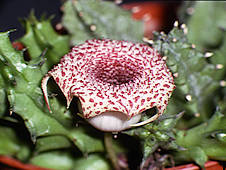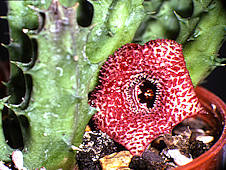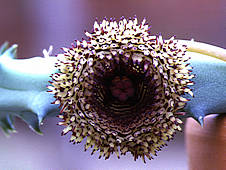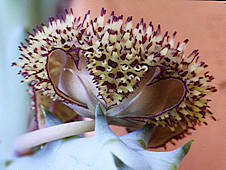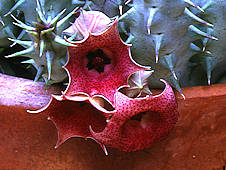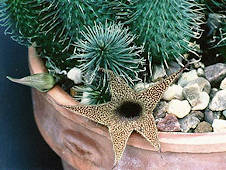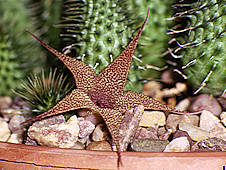Huernia R. Brown 1810
Named for: (mis-spelling of) Justus van Heurne (1577 - 1652) Dutch missionary & botanist
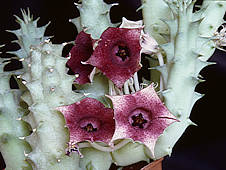
Sixty-four species of Huernia are found in eastern and southern Africa, Ethiopia and Arabia. They are low (10 cm) perennials with angular fleshy stems armed with large teeth. The grey-green stems branch from the base forming large clumps.
Attractive flowers, 2-3 cm in diameter with short stalks, are produced freely in the summer and autumn from the base or middle of the stems. The flowers which may be red, yellow or brown and often spotted, have a 5-angled margin or are 5-lobed with a characteristic small lobe in the angle between the main lobes. The flowers often produce a smell of carrion to attract pollinator flies. The strength and quality of this perfume varies considerably between different species.
|
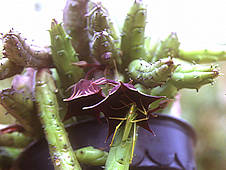
Huernia aspera N.E. Brown 1887
Name: Latin aspera = rough, uneven, refering to roughened petals
This small mat-forming succulent plant has procumbent angled stems with small degenerate leaves forming teeth. Stems root as they touch the substrate. The five-lobed flowers are dark-red to purple-black with a papillose surface and produce a foul odour to attract pollinators.
Native to East Africa: Kenya, Malawi, Mozambique and Tanzania.
|

Huernia boleana M.G. Gilbert 1975
Name: from the Bole Valley
An easily-grown Huernia, with attractively furry (papillate) flowers, about 2 cm in diameter.
The flowers produce a characteristic perfume rather similar to that of a mouse that has been dead for some time, and is especially pronounced in my clone of this species. Huernia Boleana is found growing on cliffs and grassy slopes in the Bole valley in Ethiopia.

|
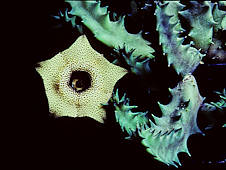
Huernia brevirostris N.E. Brown 1877
Syn. Huernia thuretii Cels ex Hérincq 1866
Name: Latin brevis = short + rostrus = beaked, billed
This variable succulent plant has angular, toothed stems that offset to form low mounds. Yellowish flowers with many tiny reddish spots are produced from the base of the stems.
Native to the Eastern Cape of South Africa.
|
|
Huernia hislopii Turrill 1922
Named for: Alexander Hislop (1880 - 1945) botanist who collected plants in Rhodesia.
The cream flowers with raised reddish spots and papillae are relatively large for this genus.
Native to mountains of Zimbabwe and Mozambique.
|
|
Huernia hystrix N.E. Brown 1876 (Porcupine Huernia)
Name: Latin hystrix spiny (like a porcupine)
This Southern African succulent plant grows easily and is free-flowering in late summer. The flowers, about 2 cm in diameter, have quite fleshy papillae and are particularly attractive.
Native to the Eastern Cape of South Africa and Southern Zimbabwe.
|
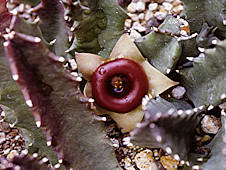 |
Huernia insigniflora C.A. Maass 1928
Syn. Huernia zebrina subspecies insigniflora (C.A.Maass) Bruyns 2005
Name: Latin insignis = remarkable, noted + flora = flower
Native to Limpopo, Mpumalanga.
|
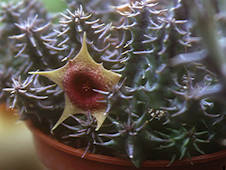 |
Huernia laevis J.R.I. Wood 1984
Name: Latin laevis = smooth
Native to Saudi Arabia and Yemen.
|
|
Huernia macrocarpa Sprenger 1892
Name: Greek macro = large + carpos = fruit
Native to Eritrea, Ethiopia, Sudan, Saudi Arabia and Yemen.
|
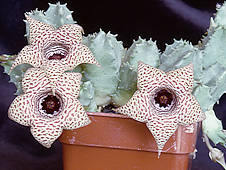 |
Huernia piersii N.E. Brown 1909
Named for: Charles Presgrave Piers (1886 - 1962) who discovered this species
Native to the Eastern Great Karoo of South Africa.
|
|
Huernia pillansii N.E. Brown 1904
An interesting Huernia from the South African Cape, which flowers freely in late summer and early autumn. The dense array of tubercles on the stems makes this species stand out in a collection or on the showbench.
|
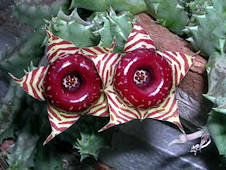 |
Huernia plowseii L.C. Leach 1988
Photo: Sebastian Boniforti
|
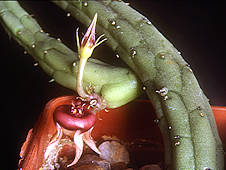 |
Huernia procumbens (R.A. Dyer) L.C. Leach 1969
|
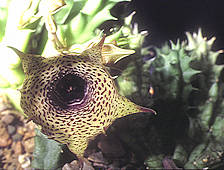 |
Huernia saudiarabica D.V. Field 1981
|
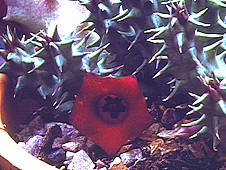 |
Huernia schneiderana A. Berger 1913
An easily-grown Huernia, although the dark-red flowers, about 2 cm in diameter, are not the most spectacular in the group. Originates from Malawi.

|
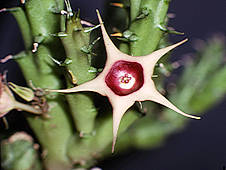 |
Huernia verekeri Stent 1933
|
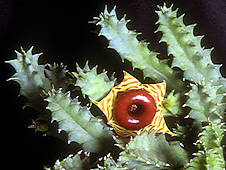 |
Huernia zebrina N.E. Brown 1909
|

 Families of Succulent Plants
Families of Succulent Plants 








